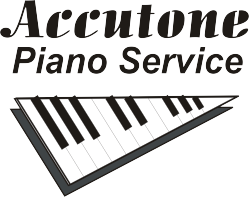It sounds so simple. Just tighten the strings until they sound good, right? Ahh, well, if it were only that simple. The piano is one of the only instruments that the pianist doesn’t personally tune. It’s up to the piano tuner to get it right. And it has to last through several seasons before it gets another tuning. It’s a lot to ask for, but that’s why we need to call a qualified person to do the job.
Technicians have a way of saying, “The piano will tell you how it needs to be tuned”. Every piano is different, and they need to be tuned slightly differently. The fact is that the pianist can’t affect the pitch of the strings directly, as a guitarist or violinist would use intonation to hone their pitch by finger placement. The pianist can only press the keys, softer or louder. Since the strings are all open, the technician must use the overtones from each string to set the proper pitch.
The pitch of the strings is raised in the upper section of the piano, and conversely, the pitch of the bass strings is lowered. This is known as “stretch”. It is a natural consequence of the fact that the overtones in steel strings appear at a slightly higher frequency than would be expected. Suppose you measure the middle A in the piano. It should be 440 cycles per second. Theoretically, the A above it should be 880 cycles. If you were to tune it to 880 and play both notes together, you would notice that it doesn’t sound right. The lower string actually produces a vibration slightly above 880. Because strings in a piano are free to vibrate, they produce many different pitches at the same time.
Make this experiment: Slowly press any key and hold it down while you hit the same note an octave higher. If you continue to hold down the first key, you’ll notice the lower note is making the sound at the same pitch as the higher one. Let go of the key, and you’ll hear the sound disappear. If you play it by itself again, you’ll hear it at the lower pitch. The string of the lower note actually contains an overtone an octave higher. The lower note also contains many more pitches within it, too. Try this: Play a middle C note without making a sound, like you did before. Now play an E note above the upper A, while you continue to hold the lower A. Notice that the lower A note is actually making the sound of E !
This illustrates the complex sound of a piano. Every string has overtones , that appear as harmonically related notes within the sound. When you play a chord, you are not only mixing the fundamental notes together, but you are also mixing all of the overtones of all the notes together. And, when you press the sustain pedal, all of the strings start to vibrate with their overtones too! WOW!
Piano tuning takes into account all of these overtones, and tries to make them match as closely as possible. Even though most tuners use an electronic device to assist in tuning the piano, he or she also needs to understand all of the complex relationships of the overtones and how they fit together to make a piano sound in tune.
I hope this helps you to understand a little more about the fascinating sound of pianos, and what piano tuning is all about.



